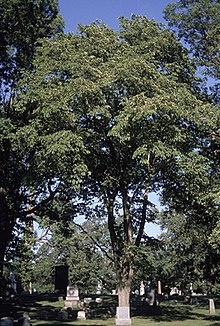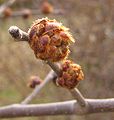Ulmus rubra
| Ulmus rubra | |
|---|---|

| |
| Mature cultivated slippery elm (Ulmus rubra) | |
| Scientific classification | |
| Kingdom: | Plantae |
| Clade: | Tracheophytes |
| Clade: | Angiosperms |
| Clade: | Eudicots |
| Clade: | Rosids |
| Order: | Rosales |
| Family: | Ulmaceae |
| Genus: | Ulmus |
| Subgenus: | U. subg. Ulmus
|
| Section: | U. sect. Ulmus
|
| Species: | U. rubra
|
| Binomial name | |
| Ulmus rubra | |

| |
| Natural range of Ulmus rubra | |
| Synonyms | |
| |
Ulmus rubra, the slippery elm, is a species of elm native to eastern North America. Other common names include red elm, gray elm, soft elm, moose elm, and Indian elm.
Description
Ulmus rubra is a medium-sized
-
Downy leaf bud and flower buds of U. rubra
-
U. rubra flowers
-
U. rubra fruit
-
Asymmetrical leaf of Ulmus rubra
-
Mature trunk bark
-
Slippery elm, Chippewa National Forest, Minnesota, 1923
-
Downy leaf-buds and seed area of samarae
-
"Old Indian Elm at Maumee, O"
Similar species
The species superficially resembles
Taxonomy
The tree was first named as part of
Etymology
The specific epithet rubra (red) alludes to the tree's reddish wood, whilst the
The reddish-brown heartwood lends the tree the common name 'red elm'.
Distribution and habitat
The species is native to eastern North America, ranging from southeast North Dakota, east to Maine and southern Quebec, south to northernmost Florida, and west to eastern Texas, where it thrives in moist uplands, although it will also grow in dry, intermediate soils.[10]
Ecology
Pests and diseases
The tree is reputedly less susceptible to Dutch elm disease than other species of American elms,[11] but is severely damaged by the elm leaf beetle (Xanthogaleruca luteola).[12][unreliable source?]
-
Red elm bark browsed by horses, Marshall, Illinois
Hybrids
In the central United States, native U. rubra hybridizes in the wild with the
Cultivation
The species has seldom been planted for ornament in its native country. It occasionally appeared in early 20th-century US nursery catalogues.
U. rubra was introduced to Europe in 1830.[8]
There are no known cultivars, though Meehan misnamed
Hybrid cultivars
U. rubra had limited success as a hybrid parent in the 1960s, resulting in the cultivars
Uses
Food
The
Medicinal
The species has various traditional medicinal uses. The inner bark has long been used as a
Timber
The timber is not of much importance commercially, and is not found anywhere in great quantity.[7] Macoun considered it more durable than that of the other elms,[28] and better suited for railway ties, fence-posts, and rails, while Pinchot recommended planting it in the Mississippi valley, as it grows fast in youth, and could be utilized for fence-posts when quite young, since the sapwood, if thoroughly dried, is quite as durable as the heartwood.[29] The wood is also used for the hubs of wagon wheels, as it is very shock resistant owing to the interlocking grain.[30] The wood, as 'red elm', is sometimes used to make bows for archery. The yoke of the Liberty Bell, a symbol of the independence of the United States, was made from slippery elm.[citation needed]
Baseball
Though now outmoded, slippery elm tablets were chewed by spitball pitchers to enhance the effectiveness of the saliva applied to make the pitched baseball curve. Gaylord Perry wrote about how he used slippery elm tablets in his 1974 autobiography, Me and the Spitter.[31]
Miscellaneous
The tree's fibrous inner bark produces a strong and durable fiber that can be spun into thread, twine, or rope
Culture
Notable trees
A tree in
Accessions
North America
- Arnold Arboretum, US. Acc. nos. 737–88 (unrecorded provenance), 172-2017 (Massachusetts), 344-2017 (Missouri).
- Bernheim Arboretum and Research Forest [1], Clermont, Kentucky, US. No details available.
- Dallas Center, Iowa, US. No details available.
- Chicago Botanic Garden, Glencoe, Illinois, US. 1 tree, no other details available.
- Ottawa, Ontario, Canada. No acc. details available.
- Longwood Gardens, US. Acc. no. L–3002, of unrecorded provenance.
- Nebraska Statewide Arboretum, US. No details available.
- Smith College, US. Acc. no. 8119PA.
- U S National Arboretum [2][permanent dead link], Washington, D.C., US. Acc. no. 77501.
Europe
- NCCPG Elm Collection.[36]Carden Park, Hollingdean (1 tree); Malthouse Car Park, Kemp Town (1 tree).
- Grange Farm Arboretum, Sutton St James, Spalding, Lincolnshire, UK. Acc. no. 522
- Hortus Botanicus Nationalis, Salaspils, Latvia. Acc. nos. 18168, 18169, 18170.
- Linnaean Gardens of Uppsala, Sweden. Acc. no. 2009–0223. Wild collected in US.
- Royal Botanic Gardens Wakehurst Place, UK. Acc. no. 1973–21050.
- Thenford House arboretum, Northamptonshire, UK. No details available.
- University of Copenhagen Botanic Garden, Denmark. No details available.
- Wijdemeren city council, The Netherlands. One tree planted gardens Rading 1, Loosdrecht.
Australasia
- Eastwoodhill Arboretum [3], Gisborne, New Zealand. 1 tree, no details available.
References
- . Retrieved 12 November 2021.
- ^ "Ulmus rubra". Germplasm Resources Information Network. Agricultural Research Service, United States Department of Agriculture. Retrieved 2008-03-14.
- ^ Plantago, Plant Index: Ulmus rubra
- ^ Hillier & Sons. (1990). Hillier's Manual of Trees & Shrubs, 5th ed.. David & Charles, Newton Abbot, UK
- ^ ISBN 9780719517907
- ^ Missouri Botanical Garden, Ulmus rubra
- ^ ISBN 9781108069380
- ^ ISBN 0-304-36192-5.
- ^ Michaux, A. (1803). Flora Boreali-Americana ("The Flora of North America")
- ^ Cooley, John H.; Van Sambeek, J. W. (1990). "Ulmus rubra". In Burns, Russell M.; Honkala, Barbara H. (eds.). Hardwoods. Silvics of North America. Vol. 2. Washington, D.C.: United States Forest Service (USFS), United States Department of Agriculture (USDA) – via Southern Research Station.
- ^ "Ulmus rubra". Illinois State Museum.
- ^ "Elm Leaf Beetle Survey". Archived from the original on 2011-07-19. Retrieved 17 July 2017.
- S2CID 7294817.
- ISSN 2153-733X.
- ^ 'Conservation status of red elm (Ulmus rubra) in the north-central United States', elm2013.ipp.cnr.it/downloads/book_of_abstracts.pdf. Cached pp. 33–35
- ^ Frederick W. Kelsey, Descriptive catalogue, no. 55, N.Y., 1906
- ^ "Herbarium specimen - E00824848". Herbarium Catalogue. Royal Botanic Garden Edinburgh. Sheet described as U. fulva; "Herbarium specimen - E00824847". Herbarium Catalogue. Royal Botanic Garden Edinburgh. Sheet described as U. fulva, RBGE specimen from Späth nursery 1902
- ^ Accessions book. Royal Botanic Garden Edinburgh. 1902. pp. 45, 47.
- ^ "List of Living Accessions: Ulmus". Royal Botanic Garden Edinburgh. Retrieved 21 September 2016.
- ^ Hillier & Sons (1977). Catalogue of Trees & Shrubs. Hillier, Ampfield, UK.
- ^ Hillier & Sons Sales inventory 1962 to 1977 (unpublished).
- ^ Green, Peter Shaw (1964). "Registration of cultivar names in Ulmus". Arnoldia. 24 (6–8). Arnold Arboretum, Harvard University: 41–80. Retrieved 16 February 2017.
- ^ Santamour, Frank S; Susan E Bentz (May 1995). "Updated checklist of elm (Ulmus) cultivars for use in North America". Journal of Arboriculture. 21 (3): 122–131.
- ^ Brookes, Andrew (2020). "Disease resistant elm cultivars" (PDF). Hampshire & Isle of Wight Branch Butterfly Conservation.
- ISBN 0-394-50760-6.
- OCLC 799792.
- ISBN 978-0-7295-3796-4., quote:
Although Slippery Elm has not been scientifically investigated, the FDA has approved it as a safe demulcent substance.
- ^ Macoun, J. M. (1900). The Forest Wealth of Canada, p. 24. Canadian Commission for the Paris International Exhibition 1900.
- ^ Pinchot, G. (1907). U S Forest Circular, no.85.
- ^ a b Werthner, William B. (1935). Some American Trees: An intimate study of native Ohio trees. New York: The Macmillan Company. pp. xviii + 398.
- ^ Anderson, Dave (August 9, 1973). "Gaylord Perry's Confession". The New York Times. Retrieved July 15, 2022.
- ^ Ulmus rubra, Cedar Crescent, Westmount, Quebec
- ^ 'L'Orme Rouge ou l'Indian Elm de la rue Cedar Crescent'
- ^ "Slippery Elm – KY". American Forests. Retrieved 2022-06-12.
- ISBN 0-231-12835-5
- ^ "List of plants in the {elm} collection". Brighton & Hove City Council. Retrieved 23 September 2016.
External links
Ulmus rubra.
- USDA, NRCS (n.d.). "Ulmus rubra". The PLANTS Database (plants.usda.gov). Greensboro, North Carolina: National Plant Data Team.
- Dr. Duke's Databases: List of Chemicals in Ulmus rubra
- Ohio DNR.gov: Slippery Elm
- Bioimages.vanderbilt.edu: Ulmus rubra photo gallery
- U. rubra, Flora of North America, www.efloras.org










